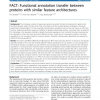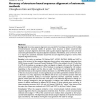40 search results - page 5 / 8 » Inferring Positional Homologs with Common Intervals of Seque... |
BMCBI
2011
12 years 11 months ago
2011
Background: Results of phylogenetic analysis are often visualized as phylogenetic trees. Such a tree can typically only include up to a few hundred sequences. When more than a few...
BMCBI
2007
13 years 7 months ago
2007
Background: The pyridine nucleotide disulfide reductase (PNDR) is a large and heterogeneous protein family divided into two classes (I and II), which reflect the divergent evoluti...
BMCBI
2010
13 years 8 months ago
2010
Background: The increasing number of sequenced genomes provides the basis for exploring the genetic and functional diversity within the tree of life. Only a tiny fraction of the e...
BMCBI
2007
13 years 8 months ago
2007
Background: Accurate sequence alignments are essential for homology searches and for building three-dimensional structural models of proteins. Since structure is better conserved ...
BMCBI
2011
12 years 11 months ago
2011
Background: Orthology analysis is an important part of data analysis in many areas of bioinformatics such as comparative genomics and molecular phylogenetics. The ever-increasing ...


